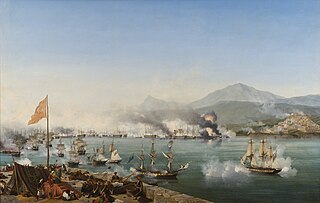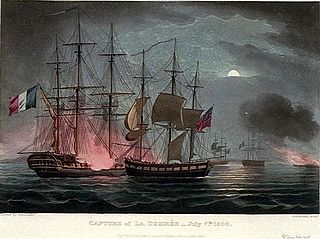This page is based on this
Wikipedia article Text is available under the
CC BY-SA 4.0 license; additional terms may apply.
Images, videos and audio are available under their respective licenses.

The Battle of Navarino was a naval battle fought on 20 October 1827, during the Greek War of Independence (1821–32), in Navarino Bay, on the west coast of the Peloponnese peninsula, in the Ionian Sea. Allied forces from Britain, France, and Russia decisively defeated Ottoman and Egyptian forces trying to suppress the Greeks, thereby making much more likely the independence of Greece.

The Battle of Fehmarn (1644) took place north-west of the island of Fehmarn, now part of Germany, in the Baltic Sea. A combined Swedish fleet, with a large element of hired Dutch ships, defeated a Danish fleet and took 1000 prisoners, including Ulfeldt, Grabov and von Jasmund. The Danish admiral Pros Mund was killed in the battle.
The Baie Chaleur Fireship, more commonly referred to as the Chaleur Phantom or the Phantom Ship, is a form of ghost light, an unusual visual phenomenon, occasionally seen in Bathurst, New Brunswick, Canada. It takes the form of an arc of light, usually seen before a storm. Its cause is unknown, but speculation includes rotting vegetation, undersea releases of natural gas, and St. Elmo's fire.
A salamander is an amphibian.

The Battle of the Basque Roads, also known as the Battle of Aix Roads was a major naval battle of the Napoleonic Wars, fought in the narrow Basque Roads at the mouth of the Charente River on the Biscay coast of France. The battle, which lasted from 11–24 April 1809, was unusual in that it pitted a hastily-assembled squadron of small and unorthodox British Royal Navy warships against the main strength of the French Atlantic Fleet, the circumstances dictated by the cramped, shallow coastal waters in which the battle was fought. The battle is also notorious for its controversial political aftermath in both Britain and France.

The naval Battle of Palermo took place on 2 June 1676 during the Franco-Dutch War, between a French force sent to support a revolt in the city of Messina against the Spanish rule in Sicily, and a Spanish force supported by a Dutch maritime expedition force.

The Noise is the 20th studio album by the English singer and songwriter Peter Hammill.

Hellburners were specialised fireships used in the Siege of Antwerp (1584-1585) during the Eighty Years' War between the Dutch rebels and the Habsburgs. They were floating bombs, also called "Antwerp Fire", and did immense damage to the Spanish besiegers. Hellburners have been described as an early form of weapons of mass destruction.

The Action at Cherbourg was fought on 21 and 22 May Old Style 1692 as part of the aftermath of the Battle of Barfleur which had just been fought on 19 May 1692.

The Action at La Hogue occurred during the pursuit by the English of the French fleet after the Battle of Barfleur on 19 May Old Style, 1692, during the Nine Years' War. The pursuing English fleet, under the command of Admiral of the Fleet Edward Russell, 1st Earl of Orford, destroyed a number of French ships that had been beached near the port of Saint-Vaast-la-Hougue.

The Battle of Gerontas was a naval battle fought close to the island of Leros in the southeast Aegean Sea. On August 29 (O.S), 1824, a Greek fleet of 75 ships defeated an Ottoman armada of 100 ships contributed to by Egypt, Tunisia and Tripoli.

The Battle of Samos was a naval battle fought on August 5–17, 1824 off the Greek island of Samos during the Greek War of Independence.

The Raid on Dunkirk of 7 July 1800 was an attack by a British Royal Navy force on the well-defended French anchorage of Dunkirk in the English Channel during the French Revolutionary Wars. French naval forces had been blockaded in their harbours during the conflict, and often the only method of attacking them was through fireships or "cutting-out" expeditions, in which boats would carry boarding parties into the harbour at night, seize ships at anchor and bring them out. The attack on Dunkirk was a combination of both of these types of operation, aimed at a powerful French frigate squadron at anchor in Dunkirk harbour. The assault made use of a variety of experimental weaponry, some of which was tested in combat for the first time with mixed success.

Dimitrios Papanikolis (1790–1855) was a naval hero of the Greek Revolution, famous for being the first to successfully employ a fireship to destroy an Ottoman ship of the line.

The Action of 14 June 1742 was a minor naval battle of the War of the Austrian Succession in which a small British squadron under Captain Richard Norris burned 5 Spanish royal galleys at the French port of Saint Tropez. Norris had surprised the galleys near Sainte-Marguerite and had chased and driven them into the French port. The British captain, in spite of alleged French neutrality, followed the Spanish vessels into the port and destroyed them at slight cost.
The Greek raid on Alexandria was an unsuccessful attempt organized by Greek bruloteer Constantine Kanaris to destroy the Egyptian fleet at its base in Alexandria in 1825 during the Greek War of Independence.














